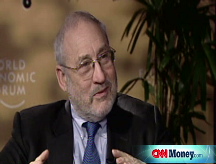Economy: Sharpest decline in 26 years
Economic activity shrank by 3.8% in last three months of 2008, according to the government's gross domestic product report.

NEW YORK (CNNMoney.com) -- The U.S. economy suffered its biggest slowdown in 26 years in the last three months of 2008, according to the government's first reading about the fourth quarter released Friday.
Gross domestic product, the broadest measure of the nation's economic activity, fell at an annual rate of 3.8% in the fourth quarter, adjusted for inflation.
That's the largest drop in GDP since the first quarter of 1982, when the economy suffered a 6.4% decline.
The decline was less than the 5.5% drop forecast by economists surveyed by Briefing.com. The fourth quarter plunge followed a more modest decline of 0.5% in the third quarter.
Still, some economists cautioned that the smaller than expected drop in economic activity wasn't good news, but a warning sign about further weakness ahead.
"Today's GDP report is no cause for celebration," said Jay Bryson, global economist for Wachovia. "The economy is even weaker than the number would suggest."
Hit by tight credit and soaring job losses, Americans slammed the brakes on spending in the quarter.
Consumer spending fell at a 3.5% annual rate, which was the seventh biggest drop on record. Spending on big-ticket durable goods plunged at a 22% pace, the largest decline since 1987. Consumer spending accounts for more than two-thirds of overall economic activity.
But it wasn't just consumers pulling back. Fixed investment in equipment and software, taken as an indication of business spending, plunged at an annual 28% rate. That's the biggest drop in 50 years.
Healthy export demand helped to lift U.S. economic growth earlier in 2008, but that strength vanished in the fourth quarter, as exports fell at nearly a 20% annual rate, the sharpest decline since 1974. That set off more concerns about the slowdown in the global economy.
"I don't want to say we were counting on the global economy to bail us out. But if it turns into a big drag, we've got more of a problem," said Gus Faucher, director of macroeconomics for Moody's Economy.com.
Faucher and other economists noted that the biggest surprise in the report was the sharp growth in business inventories.
Economists say that was false growth brought about by businesses being unable to sell the goods they had on hand. Excluding the growth in inventories, GDP would have fallen by 5.1%
"When the economy is dropping fast it is hard for firms with plummeting sales to halt inventory accumulation," said Robert Brusca of FAO Economics.
Since companies are likely to respond to the excess inventories by slashing production at the start of this year, GDP could be weaker in the next few quarters.
"As bad as this quarter was, it means the first quarter will be worse," said Faucher.
In addition, prices for goods and services fell more than expected during the quarter. That limited the decline in GDP, which is adjusted lower to account for inflation.
The prices paid by consumers during the quarter fell at an annual 5.5% rate in the quarter, due primarily to lower gas prices. That's the biggest such decline in that key price measure since the Commerce Department started calculating it on a quarterly basis in 1947.
While lower prices may provide some relief for consumers, economists warn that this phenomenon, known as deflation, can hurt economic activity.
Businesses worried that falling prices will cause them to lose money will cut back on production, which can lead to additional job losses. And even consumers who keep their jobs can hold off on purchases if they hope that prices of the goods they want will fall further if they wait.
The report comes as the Senate prepares for a vote on an economic stimulus package that is designed to pump more than $800 billion into the economy. The House passed the measure on a party-line vote Wednesday.
Christina Romer, chair of the White House's Council of Economic Advisors, issued a statement saying the weak GDP report is another argument in favor of the stimulus package.
"This widespread decline emphasizes that the problems that began in our housing and financial sector have spread to nearly all areas of the economy," she said in the statement. "Immediate action to support both the financial sector and overall demand is essential." ![]()


